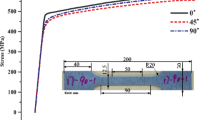Abstract
Longitudinal stretch forming is a vital fabricating process for the aircraft skin components with large dimensions. Loading trajectory of clamping jaws in stretch forming is significant for the qualified skin components fabrication. However, the traditional design methods based on estimation, experience, and trial-and-error are unable to manufacture skin components precisely and efficiently. A precision design method of loading trajectory for longitudinal stretch forming was developed and discussed in this paper. The sectional profile of the stretched sheet was considered to determine an optimal deformation state in the final stretching process. In view of the optimized sectional profile, the extending method of sectional curve was proposed to define the spatial locations of the clamping jaws. Furthermore, the numerical control parameters of the stretch forming press were transformed from the kinetic locus of the clamping jaws through the mechanism-solving algorithm and the computer-aided software was developed to integrate the methodology. For a fuselage skin component, the finite element (FE) simulation and experiment were conducted to verify the validity of the methodology of loading trajectory design and the algorithm of mechanism solving. The experimental and simulative results revealed that the developed methodology and algorithm are accurate and valid for the fabrication of aircraft skin components. By the examination of the formed skin part, the developed methodology thus provided relevant knowledge for loading locus design in longitudinal stretch forming.
Similar content being viewed by others
References
Wisselink H, van den Boogaard A (2005) Finite element simulation of the stretch-forming of aircraft skins. In: AIP Conference Proceedings, 2005. vol A. IOP institute of physics publishing LTD, pp 60–65
Oding SS (1987) Controlling the formation of double curvature skin elements on a program-controlled stretch former. Izv VUZ Aviatsionnaya Tekh [Engl Trans] 30(3):47–51
Oding SS (1987) Control of shaping of double-curvature skins on stretch-forming equipment with programmed control. Izv VUZ Aviatsionnaya Tekh [Engl Trans] 30(4):39–43
Parris AN (1996) Precision stretch forming of metal for precision assembly. Massachusetts Institute of Technology, Massachusetts
Valentin V (1999) Implementing strain control in stretch forming. Massachusetts Institute of Technology, Massachusetts
Hardt DE, Norfleet WA, Valentin VM, Parris A (2001) In process control of strain in a stretch forming process. J Eng Mater Technol 123(4):496–503
Zhang Y, Zhou X (2006) Parameter optimization in aircraft skin stretch forming process. Acta Aeronaut Astronaut Sin 27(6):1203–1208
He D, Li D, Li X, Jin C (2010) Optimization on springback reduction in cold stretch forming of titanium-alloy aircraft skin. Trans Nonferous Metals Soc China 12:2350–2357
Liu C-G, Zhang X-G, Wu X-T, Zheng Y (2015) Optimization of post-stretching elongation in stretch bending of aluminum hollow profile. Int J Adv Manuf Technol 1–10. doi:10.1007/s00170-015-7496-1
Li WD, Wan M, Zhang P, Xu CX (2004) Research on digital stretch forming system for aircraft skin. Paper presented at the 1st International Conference on new forming technology, Harbin, China, SEP. 06–09, 2004
Li WD, Wan M, Zhan Q, Xu CX (2004) Motion analysis and simulation control of numerical controlled transverse stretching machine for aircraft skin. J Beijing Univ Aeronaut Astronaut 30(2):105–108
Li WD (2007) Technological research and system development of numerical stretch forming for aircraft skin. Beihang University, Beijing (in Chinese)
Li M, Han Q, Fu W, Feng P, Liu Y (2011) Study of a flexible stretch forming machine. In: Proceedings of the international conference on technology of plasticity, Aachen, Germany, 2011. pp 655–658
Wang Y, Li M (2014) Research on three-dimensional surface parts in multi-gripper flexible stretch forming. Int J Adv Manuf Technol 71(9–12):1701–1707. doi:10.1007/s00170-014-5610-4
Yang Z, Cai Z-Y, Che C-J, Li M-Z (2015) Numerical simulation research on the loading trajectory in stretch forming process based on distributed displacement loading. Int J Adv Manuf Technol 1–10. doi:10.1007/s00170-015-7470-y
Krammer P, Rued K, Trübenbach J (2003) Technology preparation for green aero engines. In: 2003 AIAA/ICAS international air and space symposium and exposition: the next 100 years, 2003
Zhang D, Cui Z, Ruan X, Li Y (2007) An analytical model for predicting springback and side wall curl of sheet after U-bending. Comput Mater Sci 38(4):707–715
Coleman TF, Li Y (1994) On the convergence of reflective newton methods for large-scale nonlinear minimization subject to bounds. Math Program 67(2):189–224
Coleman TF, Li Y (1996) An interior, trust region approach for nonlinear minimization subject to bounds. SIAM J Optim 6:418–445
Li W, Wan M, Jin H (2005) Computer aided engineering system for aircraft stretch forming. J Plast Eng 12:200–203 (in Chinese)
Author information
Authors and Affiliations
Corresponding author
Rights and permissions
About this article
Cite this article
Peng, J., Li, W., Han, J. et al. Kinetic locus design for longitudinal stretch forming of aircraft skin components. Int J Adv Manuf Technol 86, 3571–3582 (2016). https://doi.org/10.1007/s00170-016-8456-0
Received:
Accepted:
Published:
Issue Date:
DOI: https://doi.org/10.1007/s00170-016-8456-0




